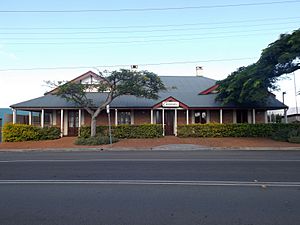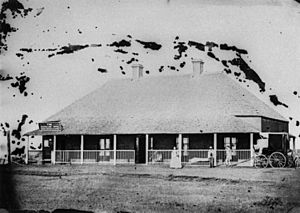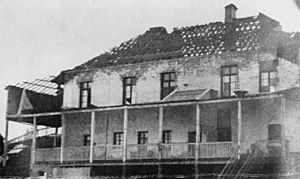Cleveland Hotel facts for kids
Quick facts for kids Cleveland Hotel |
|
|---|---|

Building in 2015
|
|
| Location | 109 Shore Street North, Cleveland, City of Redland, Queensland, Australia |
| Design period | 1840s - 1860s (mid-19th century) |
| Built | c. 1860 - 1940s |
| Official name: Cleveland Hotel (former), Cassim's Hotel, Sorrento Flats | |
| Type | state heritage (built) |
| Designated | 30 October 1995 |
| Reference no. | 601130 |
| Significant period | 1860s (fabric) c. 1860-1929 (historical use as hotel) 1940s-1960s (use as flats) 1860s-1877 (worship |
| Lua error in Module:Location_map at line 420: attempt to index field 'wikibase' (a nil value). | |
The Cleveland Hotel is an old building in Cleveland, Queensland, Australia. It's a special place because of its history. It was built around 1860 and used to be a hotel. Later, it was known as Cassim's Hotel and then Sorrento Flats. Today, it's listed on the Queensland Heritage Register, which means it's protected for its historical importance.
Contents
Hotel History
This two-story hotel was built around 1860. It was for John Vincent Cassim and his wife, Mary Teally. They had been running boarding houses and hotels in Cleveland since 1855.
John Cassim's Journey
John Cassim was from Mauritius, an island country. He arrived in Moreton Bay in 1840. He was part of a group of Mauritian people sent there. They came to help with experiments in growing sugar. Sugar was a very important crop in Mauritius at that time. It was often sent to New South Wales. These Mauritian arrivals were thought to have experience with sugar farming.
By 1844, John Cassim was allowed to live freely in Moreton Bay. In 1845, he and his wife Mary lived in Brisbane Town. It is believed that John Cassim and John Vincent Cassim were the same person. He married an Irish woman named Mary Teally around 1845. Not much is known about Mary. She had arrived in New South Wales in the early 1840s.
By 1851, John and Mary Cassim ran a boarding house. It was located at Kangaroo Point. They kept this business until late 1855.
Cleveland's Early Days
From 1855 to 1860, the Cassims rented Cleveland House. This building is now the Grandview Hotel. They also rented a house next door. These buildings were put up in Cleveland in the early 1850s. This was part of a plan to make Cleveland the main port for the Moreton Bay area. The plan didn't work out. The buildings were empty for several years. Then, the Cassims turned them into Cassim's Family Hotel and Boarding House.
In the late 1850s, Queensland was about to become a separate colony. There was new interest in Cleveland as a port. It was hoped it would serve Ipswich, which wanted to be Queensland's capital. However, Brisbane became the capital instead. Cleveland remained a quiet seaside resort. But by 1860, it was popular enough for two hotels. These were the Brighton Hotel and Cassim's new Cleveland Hotel.
Building the Cleveland Hotel
In 1858, John Cassim bought land near Cleveland House. It was on the road towards Cleveland Point. Around 1860, he built his Cleveland Hotel on this spot. The building was ready by September 1860. He took out a loan and had to insure the house. It was later found that the hotel was built slightly over the property line. So, a small piece of land was surveyed. Cassim bought this extra land in 1861.
By 1863, the hotel had many rooms. It had a bar, a parlor, sitting-rooms, and bedrooms. There was also a storeroom and a kitchen. The kitchen had a servant's room attached. Verandahs were at the front and back. The property also included stables, a coachhouse, and a garden. There was even a jetty and a bathing house. In the 1870s, Cassim bought more land next to the hotel.
The Cassim Family
Mary Cassim passed away in 1861. She was buried at Dunwich Cemetery. In 1868, John married Anne Rafter, an Irish immigrant. She arrived in Moreton Bay in the mid-1860s. John and Mary had no children. John and Anne also had no children.
John Vincent Cassim died in 1884. He was buried at Dunwich. Anne continued to run the Cleveland Hotel until 1903. She owned the property until 1916. She died in 1921 and was buried at Nudgee Catholic Cemetery.
The Cassims were well-known people in Cleveland. They were also very religious Catholics. Their hotel was famous as a seaside resort. It also served as a place for church services. This happened from the early 1860s until the first Catholic church was built in Cleveland in 1877. John helped manage the local church in the 1870s and 1880s. He never charged priests for staying at his hotel. An island in Moreton Bay, Cassim's Island, is named after him.
Changes Over Time
Around 1912, a verandah was added to the hotel's south side. The original shingle roof was replaced with corrugated iron. Around 1919, the southern gardens were divided into smaller blocks. Six of these blocks were sold.
The building was updated around 1924. It continued as the Cleveland Hotel until June 1929. A severe storm damaged it badly then. The property was sold in July 1929. It's not clear if the building was fixed right away. In 1930, the hotel's owner moved to a new hotel. This new hotel was in the center of Cleveland.
Local people believe the old Cleveland Hotel was empty for a while. It was then changed into apartments during or after World War II. This might have happened when the ownership changed in 1948. The changes included rebuilding the roof with gables and chimneys. Parts of the verandahs were removed. The front verandah's railing was replaced with wooden boards. New doors were added. The outside walls were covered with a smooth finish.
In the 1940s and 1950s, the old Cleveland Hotel was called the Sorrento Flats. The building has been empty since the 1960s. This might be after another change in ownership in 1965. In 2000, the building was restored. By 2010, it was used as office space.
Building Description
The former Cleveland Hotel faces Moreton Bay. It is on a steep slope. From Shore Street, it looks like a one-story building. But it actually has a lower floor that faces the water.
The building has a corrugated iron roof. It has two parts that stick out, called gables. There's also a verandah with a central gabled entrance porch on the street side. There are two chimneys. The gables are covered with fiber-cement sheets and wooden strips.
The west verandah has a wooden balustrade. This is a railing with rectangular open panels. There is also an east verandah on the lower floor. Its northern end and entrance stairs are damaged. The bottom of the building is made of rough stones. It has concrete supports for the east verandah.
Inside, the walls are made of smooth masonry. Some walls are made of fiber cement. The original arched entrance has been filled in with bricks. A few casement windows are still there. But most of the windows, doors, and all the French doors to the front verandah have been removed. The upper floor is made of timber. There is no way to go between floors from inside.
A wooden double garage is located to the south at street level. This garage is not considered historically important. The steep land flattens out to a foreshore area. There is a concrete wall by the water. The hotel has views across the water to Stradbroke Island and Raby Bay.
Why It's Special
The former Cleveland Hotel was added to the Queensland Heritage Register on October 30, 1995. It met these important rules:
Queensland's History
The Cleveland Hotel, built around 1860, shows how Queensland's history unfolded. It is linked to the start of Cleveland town in the 1850s and 1860s. It also shows how Cleveland became a popular seaside resort. This happened in the late 1800s and early 1900s. The building is an important part of a group of old buildings. These buildings are along the road to Cleveland Point.
Rare Cultural Heritage
This building is a rare example of Queensland's cultural heritage. It is one of the oldest buildings still standing in Cleveland. It is also a rare example of a large, two-story stone hotel from the 1860s. Even though it was changed into apartments, its original structure is still clear. It can help us learn about building methods and materials from the 1850s and 1860s in Queensland.
Special Association
The hotel has a special connection to John and Anne Cassim. They helped make Cleveland a popular seaside resort. This was in the second half of the 19th century. The hotel also played a role in starting the Catholic Church in Cleveland.



